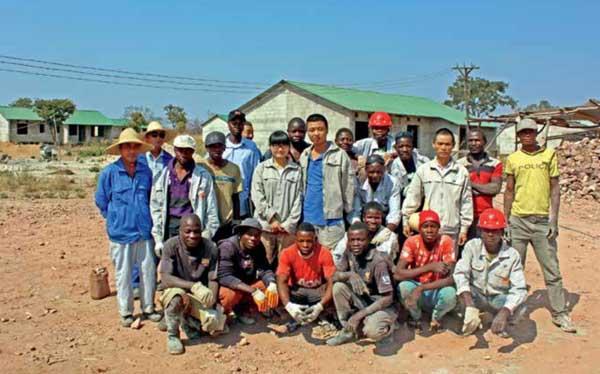A Study in Opportunity
By Humphrey Nkonde

Though a country with a young population, Zambia faces a stiff challenge to utilize its demographic advantage for economic and social growth. One major reason for this is the lack of education.
According to the UNICEF, around 4 million of Zambias 15-million-plus population are of primary school age. However, over 250,000 of them do not go to school while more than 45 percent of those enrolled in primary school drop out without completing the seven years of basic education.
The situation is worse for girls. Zambia is grappling with the issue of widespread child marriages and teen pregnancies, especially in rural areas, which force girl students to leave school even if their families have the financial resources.
According to Ministry of Education statistics, over 16,000 schoolgirls became pregnant in 2015, a rise from nearly 15,000 in 2014.
However, the number could be higher because the ministrys figures are only for those who were enrolled in school.
To address the problem, the government has made seven-year primary education free. It is also building new schools, especially in rural areas and newly created districts, to take state resources to the grassroots. When new schools are constructed, especially boarding schools in rural areas, the benefits are multiple, as Nsama has begun to discover.
Starting from the grassroots
Once a village in the Northern Province with little infrastructure, few employment opportunities and an absence of large companies, Nsama was upgraded to a district when Michael Sata became the president of Zambia in 2011. This year, the newly created district gets its first boarding secondary school.
Lawrence Chilonge, who works as a clerk for the Nsama District Council Committee, said the school would benefit Nsama residents who are forced to send their children to other, more developed but distant districts for secondary school education, and in doing so, have to spend more money on transport and accommodation.
“Most of the people here are poor and are forced to send their children to other districts such as Kaputa and Mporokoso for secondary education,” Chilonge told ChinAfrica. “This means that when the school is completed, transport costs would be reduced [for the families of enrolled youngsters].”
Zambias Ministry of Education has allocated about$5 million for building the school and the contract was given to Chinas Jiangxi Zhongmei Engineering Group.
A Chinese supervisor of the company, who declined to be named, said they are building classrooms, students hostels, a block of toilets, and a kitchen and dining hall. The project also includes 27 staff residential quarters. At the moment, teachers and other staff live in poorly constructed structures, including grassthatched huts that do not have electricity.
Chilonge said the council was impressed with the workmanship of the Chinese who complete construction projects faster than local contractors. The latter has already caused some projects to be delayed.
Jiangxi Zhongmei is hiring local residents for the work. Their 11-member Chinese technical team is assisted by about 100 Zambians.
Moses Chansa is a young Zambian working as a bricklayer on the school project. “I never had any jobs after I completed school because we did not have [big] companies working here,” Chansa said. “Nsama used to be a village once. Now it has been transformed into a district and the Chinese have come [bringing employment opportunities],” Chansa said.
He said he would put aside the money he was earning to further his education.
Moses Chishimba Chisala, a Nsama resident who works as a conservationist, said the presence of the school would encourage small-scale farmers to grow rice and beans so that they can sell the products to the school.
Nsama has the potential to grow rice because it is surrounded by the Tanganyika, Mweru wa Ntipa and Chishi lakes. Moreover, fishermen can fish in these lakes and sell their catch to the school.
Chinese construction expertise
Jiangxi Zhongmei has been involved in building schools in other provinces of Zambia as well.
In the Western Province, it built the Limulunga Day School, which Zambian Education Minister Michael Kaingu said would be turned into a boarding school. In the Eastern Province, it implemented the Eastern Province Middle School project. Working with the Zambian Ministry of Health, it has also constructed a hospital.
Other Chinese companies in Zambia too are associated with education and knowledge transfer at various levels and in varying degrees.
The Chinese state-owned Sino Hydro Corp. Ltd., which is building the 750-mw Kafue Gorge Lower hydropower project in Zambia, for instance, has announced it would establish a training school at the project site to give three months training to employees.
Chinese construction has a long history in Zambia, going back to the 1970s when the Chinese built the Tanzania-Zambia Railway connecting Tanzanias Dar es Salaam Port with Kapiri Mposhi Town in Zambia. It was Chinas largest single foreign-aid project.
In recent times, China and Zambia , through the China Development Bank, have signed a $418-million loan agreement to repair and rebuild roads in the Copperbelt area, Zambias industrial base and mainstay of the economy. It is a project under the Forum on China-Africa Cooperation (FOCAC).
The Chinese Governments assistance for Africa, routed through the FOCAC, has increased. From the$20 billion pledged in 2012, it tripled to $60 billion in 2015. The Zambian Government is hoping new projects can be implemented with the augmented funds, especially in infrastructure development, broadband communication and rehabilitation of the existing railway network.

